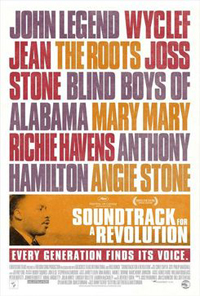Media/Arts
Soundtrack for a Revolution, a 2009 film by Bill Guttentag and Dan Sturman, revisits the American civil rights movement with a focus on how the music of protest on picket lines, in jail cells, and in organizing meetings were a source of courage, solidarity, energy, and comfort. John Lewis, one of the early Freedom Riders and now a congressman from Georgia, is interviewed extensively for this documentary. He says, “It was the music that gave us the courage, the will, the drive to go on despite it all,” referring to songs such as “Will the Circle Be Unbroken?” “Which Side Are You On?” and “We Shall Overcome.” Using mostly black and white archival news footage, the film shows the frightening brutality faced by the early civil rights foot soldiers and reminds us of one of the most shameful chapters in American history. It covers a period beginning with Rosa Parks and the Montgomery Bus Boycott and ends with the assassination of Martin Luther King, Jr., in 1968. Having grown up during this period, I didn’t expect to be surprised by the news accounts—but I was. I had some memories from television coverage of the fire hoses, the attack dogs, the billy clubs, and the white rage aimed at the peaceful marchers. But as a child and teenager during this period, I didn’t fully realize how serious the threat of physical violence was for so many of the brave, nonviolent protesters. Soundtrack for a Revolution provides important history lessons and could be used as an educational tool in junior high, high school, and college settings. I think it would astonish many students that not long ago, a person of color was unable to get service at some lunch counters and not allowed to vote or attend a public university. Though our country seems polarized today, the domestic violence of 50 years ago provides a useful reminder of what we were (are?) able to endure as a country. Along with Lewis, there are numerous other talking-head interviews in this film. Harry Belafonte, Andrew Young, and Julian Bond are some of the speakers who expressively share their experiences during the civil rights movement. It was particularly moving to see and listen to the various speeches and sermons of King. We see him collapse from utter exhaustion after his famous 1963 “I Have a Dream” speech. It is haunting to hear his words and see his facial expressions during his last speech in Memphis, as if he senses his assassination is imminent. The powerful music and lyrics that served as the backdrop of the civil rights movement came from the black churches and the labor movement, the latter currently at risk again at this time in our history. The music of these movements almost demanded participation, as it did for many social workers who were part of these movements. Being inspired by the music that helped people endure and persevere as portrayed in this film is a great way to honor social work’s proud past and celebrate National Professional Social Work Month! — Robert DeLauro, MSW, ACSW, is a freelance writer and consultant with the Labor Management Project in New York City. * Author’s Note: Advances in technology happen so fast that it can be difficult for some people to keep up. I’ve had a Netflix account for several years, but only within the past few months have I realized what a goldmine it is for documentaries. Click a button (and pay a minimal monthly subscription fee) and the film is available. This is not a plug for Netflix, but I’m sharing this information for those who have an interest in documentaries and have found them hard to locate in theaters. |

 A Film Review of Soundtrack for a Revolution
A Film Review of Soundtrack for a Revolution